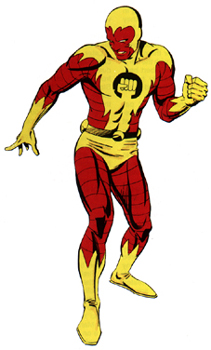Gary Gilbert
Gary Gilbert was born in Detroit, Michigan. A superpowered enforcer for corrupt industrialist Justin Hammer, as Firebrand he is a former radical activist saboteur who turns to violence after believing peaceful protest produced no results. [2] Firebrand's "clenched fist" logo on his chest recalls the Black Power movement. [1]
In his first appearance in Iron Man #27 (July 1970), Firebrand describes his experiences demonstrating for the civil rights movement in a speech to Iron Man:
"I'm just an all-American boy, Iron Man, one of those wide-eyed innocents who started out to make the world a better place. I sat in for Civil Rights, marched for peace, demonstrated on campus, and got chased by vicious dogs, spat on by bigots, beat on by "patriots", choked by tear gas, and blinded by mace until I finally caught on. This country doesn't want to be changed! The only way to build anything decent is to tear down what's here and start over."
While the story includes some positive messages about the civil rights movement, Firebrand is presented as a villain, because he sets himself outside of the existing political structure, and is willing to let innocents die to further his political and social aims. In his article "Everyday Heroism in Superhero Narratives", Michael Goodrum writes, "Having pursued tactics of accommodation without result, he turns to confrontation, asserting that there is nothing of value left in the system if it treats peaceful reformers with violence — essentially laying bare the coercive nature of power. It is Firebrand's absolutism that marks him as a villain in terms of the narrative." [3]
Firebrand accidentally killed his own father. [4] He also won the Black Lama's "War of the Supervillains". [5] He then fell to alcoholism and gave up political activism only to work for other villains because he "needed the work". [6] He later gave up his costumed identity and became a "supervillain agent", brokering employment for other costumed villains. [5] [6]
When news of the Scourge of the Underworld's initial wave of supervillain murders spread among the criminal community, Gilbert took it upon himself to gather several costumed criminals for a meeting to determine what should be done about this menace. The meeting, held at an abandoned tavern in Medina County, Ohio, known among the criminal underworld as "The Bar With No Name", turned out to be a massacre, as Scourge infiltrated the event disguised as a bartender; a few minutes into the meeting, Scourge slaughtered every criminal present, including Gilbert, with machine gun fire. [7]
Firebrand was later among seventeen of the criminals murdered by the Scourge, who were resurrected by The Hood using the power of Dormammu as part of a squad assembled to eliminate the Punisher. [8] After the Punisher is captured, he is present at the ritual where the Hood intends to resurrect the Punisher's family. Microchip shoots G. W. Bridge in the head, which activates the ritual using Bridge's life force to resurrect Microchip and Punisher's families. The Punisher refuses to accept this, and forces Firebrand to burn his family alive, and then Punisher shoots Firebrand in the back of the head. [9]
Russ Broxtel
After Gilbert's death, a man named Russ Broxtel becomes Firebrand and joins the Force of Nature. [10] With Force of Nature, he also battled Cloak and Dagger and the New Warriors. [11] Firebrand was later hired by R.A.I.D and helped into London by Fasaud. The Arabian Knight confronted Firebrand who struck back with a wall of flame. Protected by his magic uniform, the Knight stopped Firebrand. [12]
After Civil War, Firebrand returned to the United States. Donning a new suit, he attempted to rob a gas station. He was stopped by Young Avengers members Hawkeye and Patriot. [13] Firebrand escaped and was later seen along with King Cobra, Mauler and Mister Hyde, who attacked Yellowjacket, Constrictor and other Initiative staff and trainees. [14]
Richard L. "Rick" Dennison
Richard L. "Rick" Dennison was the third Firebrand. He was an anti-capitalist eco-terrorist who worked with a group called the Flaming Sword, and he fought Iron Man on several occasions. [15] After he recovered, Firebrand returned with the Flaming Sword and kidnapped Osborn Chemical vice-president Charles Standish. He was then confronted by the Avengers and he was defeated. [16] Firebrand later appeared as a member of the Shadow Council's incarnation of the Masters of Evil. [17]
Baron Zemo later recruited Firebrand, Flying Tiger and Plantman II to join his "New Masters". They later encounter Steve Rogers, the original Captain America, Free Spirit and Jack Flag. During the fight, Firebrand is defeated by Free Spirit. [18]
